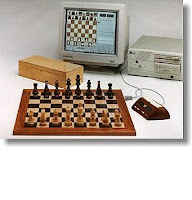
Possibly…
There was an article in the New
York Times a few months ago about a star hedge fund manager on Wall Street
named Boaz Weinstein who was also a master. And then there is Peter Thiel, the
billionaire co-founder of PayPal who now runs the hedge fund Clarium Capital,
who also happens to be a master.
Many good chess players were
also good at bridge; Reshevsky for one enjoyed the game. Top of Form
Warren Buffet is an accomplished bridge player and David Einhorn, president of
Greenlight Capital finished 18th in the main event of the 2006 World Series of
Poker. But being skilled at games is no guarantee of success. James Cayne, the
former chief executive of Bear Stearns, is a world-class bridge player who has
won many international bridge tournaments. OK, Bear Stearns collapsed in 2008,
but still…
IM Norman Weinstein (no relation
to Boaz Weinstein) also had a successful career as a Wall Street Trader. GM
David Norwood was also a trader for a brief period of time, but quit after a
couple of months because he didn’t know what he was doing. But a year later he
got back into the banking business and in 2008, at the age of 40, retired a
multimillionaire.
The Web site of the hedge fund
manager D.E. Shaw Group lists among its employees a life master at bridge, a
past “Jeopardy!” champion and Anna Hahn, the 2003 US women’s chess champion.
Ms. Hahn is a senior trader.
Patrick Wolff, a two-time US
Chess champion, worked as an analyst and rose to become one of the managing
directors at Clarium. This year, he set up his own fund, and, in a reference to
his chess background, named it Grandmaster Capital.
At Talpion, a hedge fund started
earlier this year by billionaire investor Henry Swieca, one of the fund’s
senior traders is Matthew Herman. Never heard of Matthew Herman? For many
years, Herman’s international rating was 2,149, mostly because he rarely played
and almost never entered tournaments.
Herman graduated from the State
University at Albany at 15 and received a master’s degree in mathematics from
Brown two years later. When he was 18, he went to work at Goldman Sachs. That
is when he started playing chess again, but only in small US tournaments. In late
2010, he took a hedge fund job and treated himself to a European vacation
before he started. While in Europe he entered several tournaments and performed
well. He tied for first with four grandmasters at the Memorial Crespi
tournament in Italy and won the title on a tie-breaker. At the Ascona Chess
Festival in Switzerland, he tied for third and beat Mihajlo Stojanovic, a
Serbian grandmaster.
Then there is GM Maxim Dlugy. Dlugy was born in
Moscow and arrived with his family in the US in about 1979. Dlugy
was a late developer and was only an average player until he shot up in
strength in the early 1980s, winning the World Junior Championship in 1985 and
becoming a GM in 1986.
Dlugy was also involved in chess politics and was elected President of the
USCF in 1990. Banker’s Trust placed an ad in the New York Times for young chess
masters believing that they would make good securities traders and
Dlugy answered the ad and was hired. He worked on Wall Street, eventually
becoming a principal of the Russian Growth Fund, a hedge fund. Kasparov was
formerly associated with Dlugy's Russian Growth Fund.
In 1991 Dlugy stopped playing
chess and went to financial business back in the Soviet Union. Things went
pretty well until 2005 when he was arrested by the Russian police on fraud
charges.
He was detained by police at the Moscow airport after immigration records
revealed that there was an outstanding warrant for his arrest and after a
year-long investigation prosecutors accused him of trying to defraud the owners
of Russia's second biggest magnesium plant. He was accused of issuing more than
£4 million worth of bonds backed by the plant without the knowledge of other
board members. The prosecutors claimed that the bonds were sold to three
companies that had been illegally registered using stolen passports or
documents of dead people. Finally,on
December 20, 2005. Dlugy was acquitted of all charges,
after spending eight months in jail.
Another promising US player, Ken Rogoff (1953- ) became a Grandmaster in
1978 and then retired from chess, earned a PhD in Economics from M.I.T. in
1980, and became the chief economist at the World Bank. Early in his career,
Rogoff served as an economist at the International Monetary Fund and at the
Board of Governors of the US Federal Reserve System. He is an elected member of
the American Academy of Arts and Science as well as a Fellow of the Econometric
Society and a former Guggenheim Fellow.
Rogoff also served as the Charles and Marie Robertson Professor of
International Affairs at Princeton University and later served as Economic
Counsellor and Director, Research Department of the IMF, from August 2001 to
September 2003.
In 2002, Rogoff was in the spotlight because of a dispute with Joseph
Stiglitz, a former Chief Economist of the World Bank and 2001 Nobel Prize
winner. Stiglitz had criticized the International Monetary Fund in his book, Globalization and Its Discontents, which
got Rogoff’s dander up.
Before them, Al Horowitz
had been a securities trader on Wall Street with some other chess masters:
Maurice Shapiro, Mickey Pauley and Albert Pinkus. Horowitz gave it up to devote
himself to his chess career. Maurice Wertheim was an investment banker who
financed much of the activity in American chess during the 1940s.













